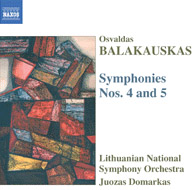|
FEATURE. Osvaldas Balakauskas: an Enthusiast Modernist in the Times of Post-modernism
|

photo: Dmitry Matveyev
| "Modernism is losing ground as a revolution, as a denial of tradition par excellence. [...] It can be said that I reject the principles and techniques of modernism, as I have already tried them and know how this kind of music functions," asserts composer Osvaldas Balakauskas, the winner of the Lithuanian National Prize, who has been occupying a strong position on the top of modern Lithuanian music since the mid-1960s as one of the most remarkable artists and leading authorities. Balakauskas has made a great influence on several generations of composers: once he used to draw young composers into the mysterious 'Balakauskas orbit' solely by the charm of his music, and later, starting from the mid-1980s - by teaching at the Lithuanian State Conservatoire (now the Lithuanian Academy of Music and Theatre, where he has been heading the Composition Department for many years). Kiev lessonsTaking into account his authority as an influential composer and teacher, Balakauskas seems to have mastered the secrets of composition by himself, by trusting his own intuition rather than some teacher's guidance. Because of his 'excessive' predilection for jazz and other non-existent sins, he had to seek shelter outside Lithuania. Thus he found himself in the Ukraine, where he studied composition with Boris Lyatoshinski at the Kiev Conservatoire. The professor tried to be tolerant to all youthful quests and escapades - his relations with the students, as it were, were based on the principle of 'non-interference'. Thus the young artists expanded their horizon and quenched their hunger for innovation basically outside the walls of the Conservatoire, avidly hunting for the instances of the post-war West European musical avant-garde that were seeping through cracks of the iron curtain. This circle of progressive-minded students included now famous Ukrainian composers Valentin Silvestrov and Leonid Hrabovski, among others. On his own wayPerhaps it was another reason why Balakauskas' work was at first received with a certain distrust in Lithuania: he appeared like an intruder in the panorama of Lithuanian music; his musical language and aesthetic principles were alien to the tenets of traditional Lithuanian school, which determined the 'national style', growing from a synthesis of the essentials of Lithuanian folk music and modern European composition. Balakauskas' music was again accused of formalism, cosmopolitism and emotional coldness. The ear of the authorities and conservative-minded colleagues was offended by a certain alienship and abrasiveness of his music - sometimes even by such details as the altered sound of prepared piano or amplified cello, or reversed tape with recorded instrumental parts. Yet for the composer's contemporaries, this music carried a special message of novelty and freedom, as if announcing a possibility of a different, independent attitude (though in fact it was pure music, free of any political declarations). The attempts at direct arguing with the composer were nonetheless scarce, and those who tried this were disappointed: possessed of an incisive mind, a highly intelligent person, Balakauskas always disarmed his opponents with his calm and well-grounded speech. His great diplomatic talent, along with his feeling of social responsibility, contributed to his distinguished social and political career in the times of the Lithuanian national revival movement: Balakauskas was elected to the Council of the Lithuanian "Sąjūdis", and later appointed the ambassador of Lithuania to France, Spain and Portugal - the first ambassador after the half-century of Soviet occupation. All this did not put the composer off his stride - his creative work. Balakauskas is one of the most prolific Lithuanian composers; his oeuvre includes five symphonies, more than ten concertos, a chamber opera, a ballet and numerous other, mostly chamber instrumental compositions. Very exacting to the work of his colleagues, as well as his own, the composer is always searching for answers to the questions of the nature and raison d'être of music, and has also distinguished himself as an insightful and accurate critic and theorist. He is one of the few contemporary composers who have created, developed and documented their own unique and precise system - which he sets forth in his treatise "Dodecatonics". This work not only explains the composer's creative principles, but also reveals his original view of the inherent laws of the Western musical tradition and their natural psychoacoustic foundations, and by the significance of analysis and conclusions could be well compared to the great systems of Schönberg, Hindemith or Messiaen. Dodecatonics - what is it?Dodecatonics can be defined as the formation and elaboration of new tonal connections between all twelve tones of the chromatic scale, or part of them (from one-tone system - monotonic, to twelve-tone system - dodecatonic; the composer uses some of them more often than others - e.g. eight-tone octatonic or eleven-tone enneatonic, employing their specific modal and harmonic potential). Interestingly, not only the single sound could serve as an element of the n-tone series, but some group of sounds, a chord, a motif, or even a fragment of the existing music with its stylistic identity as well. All that gives his music a special, immediately recognisable colour (often called "Balakauskas' tonality"), while the active rhythm (based on no less strictly calculated additive and symmetrical progressions), as if accumulating and releasing vast resources of energy, makes it even more vital. Also interesting is the fact that all those innovations perfectly match the almost classical forms of his compositions (sonata, symphonic cycle, etc.). Balakauskas is a master of instrumentation as well, resourcefully exposing and combining radiant colours of different orchestral groups, emphasising the individuality and charm of timbre of solo instruments, sometimes enriching the sound with sparingly used electronic means. Paradoxically, these strict, mathematically calculated constructions are not perceived as a theoretical speculation and are not reminiscent of the classical examples of the Western avant-garde - the composer is always able to infuse a certain identifiable stylistic flavour into them. These structures may sound similar to neo-baroque (flute concerto Bachjahr, 1985), neoromantic ( Like a Touch of a Sea Wave for violin and piano, 1975) or impressionistic music (Impresonata for flute and piano, 1964), or they may come close to a mediaeval chant (Requiem in memoriam Stasys Lozoraitis, 1995) or jazz (Bop-Art, versions for various instruments, 1995). His system allows him to include various other attributes of 20th century composition as well - such as controlled aleatorics, sonoristics, minimalism, electronic music, even stylistic collages, etc.
Retrospects and prospects
From the mid-1990s, Balakauskas started emphasising the losses of modern music and the importance of communication with the listener and tradition in the broad sense ("'new phenomena' have become such a banal phenomenon, that the return to the old phenomena is probably the most important new phenomenon of our times"). Consequently, his music of that time was marked by increasing transparency of textures, more contemplative moods, imbued with consonant, quasi-tonal harmonies and breathing with 'endless' melodies. The most distinct examples of this peculiar 'neo-classicism' in the composer's work are the mentioned Requiem in memoriam Stasys Lozoraitis and Symphony No. 4 (1998). Yet the composer did not linger at this oasis of somewhat 'rarefied air' for a longer time: in the compositions, written before and after the turn of the millennia, such as Dal vento for cello and piano (1999), Odyssey from B to C for flute, guitar and string quartet (2002), and Music for Strings - Homage to Bartók for piano, harp and string orchestra (2006), a certain edginess and bursts of extremely concentrated energy typical of Balakauskas' earlier works can be found again, along with the manifested restraint of expression. And, certainly, the composer's old passion for jazz is evident in syncopated rhythms, quasi-improvisational melodies and harmonies imbued with 'bluesy' chromaticisms.
One of the most often internationally performed Lithuanian composers, Balakauskas continues to compose with ever increasing intensity. During the next months there will be plenty of opportunities to hear his music both at home and away, particularly in Germany. In the framework of the project "scene: estland lettland litauen in nrw" on May 16 in Dortmund and May 19 in Cologne, the St. Christopher Chamber Orchestra under Donatas Katkus together with harpist Florence Sitruk will premiere his new Concerto for Harp and Strings (it will make a diptych with the recently composed Music for Strings, commissioned by the Budapest Radio in commemoration of the 125th anniversary of Béla Bartók, to be premiered later this year). A special part of the "scene" project, "Musik unserer Zeit" taking place in Münster in late May-early June, will present a possibility to trace the development of Balakauskas' style and compare his works of various periods. Along with the more recent compositions (Odyssey from B to C; Dal vento; Tristan for flute, guitar and piano, 1998), his early pieces (Impresonata; Cascades-1 for piano, 1967; and Rain for Cracow for violin and piano, 1991) will be also performed.
© Linas Paulauskis
Lithuanian Music Link No. 12
Symphonies by Osvaldas Balakauskas released on Naxos
Two large symphonic works by Osvaldas Balakauskas - the Fourth and the Fifth symphonies - have been recently released on Naxos. Both works recorded by the main inspirer and first performer, the Lithuanian National Symphony Orchestra under its artistic director Juozas Domarkas.
"These two symphonies from Lithuania are interesting, entertaining works," says David Hurwitz of ClassicsToday.com in his review. "Balakauskas is one of those composers who writes according to a strict system, the details of which are less important than what he makes of it expressively - and the answer to that question is: quite a bit."
Balakauskas is always able to infuse a certain recognisable stylistic flavour into his mathematically built constructions, which could sound as similar to neoromantic or impressionistic music, as to jazz. The synergy of intellect and elegance is what distinguishes his work, as well as steadfast adherence to his own rules of composition, a virtue of being an enthusiastic modernist in the times of ubiquitous post-modernism.
Symphonic works comprise one of the most important parts of Balakauskas' output. The highlights of Balakauskas' symphonic music include Sonata of the Mountains (Concerto for piano and symphony orchestra, 1975), Symphony No. 2 (1979), and Opera strumentale (1987). Symphonies No. 4 (1998) and No. 5 (2001) represent the new direction in Balakauskas' work, a growing transparency of textures, neo-classical restraint of expression and balance of form and emotion.
 |
"I feel confident that Balakauskas is a very distinctive voice in today's symphonic world," states Göran Forsling in MusicWeb International, admiring Balakauskas' instrumental and textural innovations, as well as melodic patterns, "some of them - of extraordinary beauty". According to the critic, the last movement of the 5th symphony "would be a riveting encore for any symphony concert and it would surely bring the house down".
This recording is the second collaborative project of the Music Information and Publishing Centre and Naxos.
Osvaldas Balakauskas. Symphonies Nos. 4 and 5
Lithuanian National Symphony Orchestra, Juozas Domarkas (cond.)
Naxos, 8.557605, 2005
|
|
|


